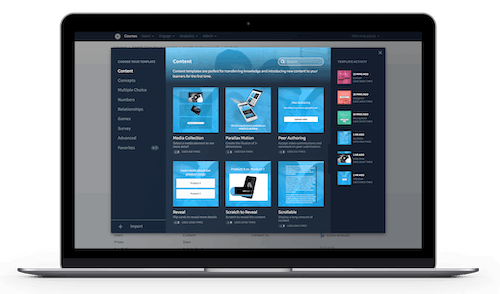eTraining

eTraining is a form of eLearning but is naturally more focused on activity and process. While it cannot replicate the activities of experiential learning, it can define how to perform those activities. As such it’s a potentially very useful way to instruct employees on your organization’s latest process, behavioral and operational requirements.
What is eTraining?
eTraining or e-training means training with an electronic platform. Companies can use it to teach employees without assembling them in one location at the same time. This saves considerable time, effort, and organizational strife and ensures that an entire workforce can be kept up to date with the latest procedures and policies.

Sign Up For Free And Start eTraining With The Best LMS. No credit card required.
What are the benefits of eTraining?
Utilizing e-Training means that you don’t need all of your employees in one place or even at the same time. Instead, they can complete courseware from remote locations or simply at home. In many cases, they needn’t be online together either although you could still schedule everyone to watch a broadcast at the same time before interacting with it. However, while live broadcasts can only be ‘aired’ once, on most occasions, eTraining lectures and lessons can be accessed at any time.
It can still take a great deal of time to prepare an eTraining course – many weeks in many cases. While it’s possible to outsource this work, be aware that doing so tends to be expensive. Also note that large courses frequently need updating and if you’re outsourcing, that can get increasingly expensive.
Electronic Training Methods
With the proliferation of technology, there are several eTraining methods that you can choose based on your resources. Let’s look into some examples that you can use to best suit your training strategy.
Mobile Learning
With everyone practically owning a smartphone, mobile learning has become a popular format for eTraining due to its ease of access and availability. As the name suggests, training is delivered straight to your learners’ mobile devices. In this technological age, mobile learning serves as the best solution in keeping up with the learning trends and adapting to the hectic schedules of your employees. Mobile learning allows learners to access learning materials across multiple devices, especially on smartphones.
With a mobile-first LMS like EdApp, you have full control over course management, and your employees can access training materials conveniently in one platform. Learners can access bite-sized courses from their smartphone whenever they have 5 minutes to spare – whether that’s on their commute, in between meetings, or on a break. For teams or individuals who don’t have consistent access to WiFi, EdApp also has an offline mode where learners can download their courses whenever they have internet access and automatically sync their results when they’re back in range.
Web eLearning
This entails the use of a dedicated website where students can access their courses, modules, tasks, and activities. Here, you can leverage the web-based tools that your organization already uses. and there’s usually no need to install any software or application. Training is easily accessible and can take place as long as learners have access to a reliable internet connection and a modern browser. Using EdApp gives learners the option to access perfectly formatted courses and modules both through their mobile device and computer’s browsers. This gives you total flexibility when it comes to lesson delivery.
Virtual Classrooms
The goal of virtual classrooms is to boost social interaction and ensure success in an online learning environment even without being in a brick-and-mortar training room. With this eTraining method, you can reach and train your team without compromising face-to-face interaction. EdApp’s Virtual Classroom feature enables you to schedule recorded, in-app meetings and check-ins with your learners using your preferred video conferencing platforms, such as Zoom and Microsoft teams. Video meetings can be linked directly to a course for discussion to foster collaboration through the exchange of ideas, knowledge, and experiences.
Additionally, EdApp’s forum-like Discussions feature forces learners to reflect and apply the knowledge immediately as part of their course. This gives you the opportunity to comment and lead the discussion when necessary, and provide real-time feedback to your team. By harnessing the power of peer learning, learners are 16 times more likely to finish their courses and are more likely to develop a deeper understanding of course content when they teach it to someone else.
Microlearning in eTraining
An increasingly popular form of eLearning is microlearning and this directly translates into the world of electronic training. Instead of utilizing large courses, chunking lessons into bite-sized microlessons format enables instructors to more-effectively pass on information (and have their audience better take it on board) making the training process significantly more effective.
Using microtraining in this way means it’s dramatically quicker to author courseware – potentially minutes instead of weeks – and that the barriers for people creating the courses drop quickly. This in turn means that updating elements of courseware is relatively quick and painless and doesn’t involve expensive content updates and, in some cases, entire course republishing (just because a part in the middle became outdated).

eTraining LMS
LMS can be applied in a very simple system but also in complex distributed environments. LMS learning management systems integrate tools for implementing a virtual classroom. The must-have features of LMS are:
- Learning content and navigating through them – navigation tools allow you to arrange the learning content in a certain order and help the user to move through the knowledge space
- Knowledge testing – implemented most often through tests and quizzes for self-assessment, but may also include grading
- Authoring tools – enable the storage of educational content on a web server, their appropriate connection, and the creation of tests and discussions;
- Course management – various administrative data on uses and on the course being studied are kept;
- Monitoring – correct and incorrect answers are recorded based on lessons and other activities, which enables monitoring of users success and production of statistics
- Computer-mediated communication (CMC) – allows learners and lecturers to communicate with each other, which can be private and public as well as synchronous and asynchronous.
eTraining Course Development Solutions
Before creating your course, it’s important to be aware of the different eTraining course development solutions that you can utilize to maximize your learners’ potential. With the evolution of technology, organizations have found new and wonderful ways to make use of different digital tools to create learning materials for their employees. Some of these existing eTraining solutions include:
Video software solutions – These tools allow learning and development professionals to create highly engaging video content for their learners. These usually come in the form of webinars, video tutorials, software tutorials, and embedded videos.
Online quiz makers – These learning solutions are great for reinforcing previously learned training concepts. They also help organizations get instant feedback regarding their overall performance, including skill and knowledge levels. They’ll also be able to identify knowledge gaps and address them in future training sessions.
Interactive eLearning gamification tools – Gamification tools help companies provide their learners with a fun and engaging learning experience through interactive smartphone-like game elements. These interactive solutions can also motivate learners to progress through their training more easily and engage in healthy competition with their fellow learners.
Virtual reality training tools – This eTraining solution allows companies to replace workplace scenarios that can be too difficult, expensive, or dangerous to access and train for. learners to immerse themselves in lifelike scenarios without having to go to a special facility for training. Virtual reality helps replace workplace scenarios that can be too difficult, expensive, or dangerous to access and train for. Some of the industries that use this eTraining method to facilitate learning include healthcare, construction, aviation, and transportation.
What do you need for eTraining?
To perform electronic training you’re going to need a Learning Management System or LMS. This is software that helps create and operate training courses. There are many varieties that are generally separated into those which provide course content and those which allow you to create your own content. The prices can vary considerably but before choosing, it’s worth checking out the latest iterations which are based on the concept of mobile LMS.
Better eTraining with microlearning
A mobile LMS allows you to create Training courses for mobile phones. At a time where smartphone saturation is nearly ubiquitous, it makes sense to leverage these ownership levels and allow your students and employees to access microlessons on their own terms (where and when they want) using their own devices. Doing so dramatically reduces logistical challenges and means that your audience is far more likely to complete courseware in a timely fashion and absorb the required information much more effectively.

Etraining with EdApp LMS
e-training with EdApp LMS and authoring tool can help with your training, get in touch at enquiries@edapp.com. You can also try EdApp’s Mobile LMS and authoring tool for free by signing up here.
Curated course examples
Author
Guest Author Daniel Brown
Daniel Brown is a senior technical editor and writer that has worked in the education and technology sectors for two decades. Their background experience includes curriculum development and course book creation.
